
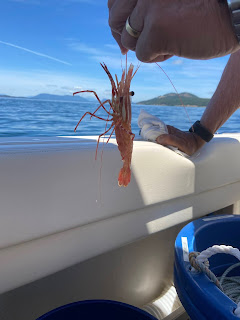


Left: View over Nelson Bay at the isthmus of Henry Island. Center left: A spot shrimp just caught, Pandalus platyceros. Center right: The north end of Spieden Island. Right: A boating life always includes a good rosé wine.
So much of our personal experience of the Pacific Northwest involves lush green forests and mountain ranges where we've hiked and played for years. We haven't spent much time on the coasts and we forget how beautiful and important the Pacific Ocean is to the identity of the region. Recently, we got the chance to spend time on the edge of the Pacific. We spent time on the water in the San Juan Islands, Washington and then again on the coast in Pacific City, Oregon. In this post, we'll talk about our few days on Henry Island in the San Juan Islands and in a future post about our time in Pacific City.
From ski to sea
Pulling away from the Anacortes ferry station one Thursday early evening, we leave our car behind and enter into the "island life". Green and brown dots of Riven-esque landscapes fly by our salty ferry window and before we know it, we are in Friday Harbor on San Juan Island. Our friends are waiting in a small Grady White that runs us around the north side of the island to our lodging on a small yacht anchored off of Henry Island, on the northwest side of San Juan Island.
A prawning life
The focus of our few days staying on Henry is prawning. It's prawning season and our friends are hardcore. Day one is a crash course for us in how to use bait to attract prawns, how and where to set the pots (traps), how to clean the captured prawns, and then how to enjoy them. It's fascinating and exhausting. After one hour on the water on day one, I'm ready to go back. But alas we have several more hours to go and a second day of prawning ahead of us.



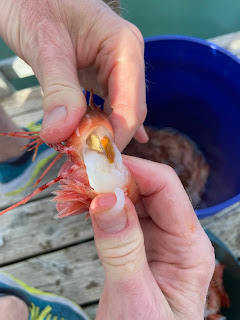
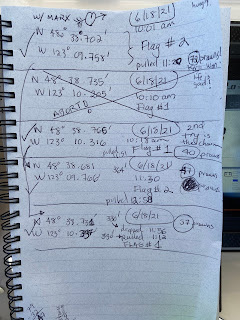

From left to right: Mixing up the bait for the shrimp traps. Transferring shrimp from trap to holding bucket. A spot shrimp, Pandalus platyceros, freshly caught in the San Juan Islands. Taking the head off of a spot shrimp. A log of where the traps were set. Spot shrimp ready to go on the barbeque.
Understanding prawning and its season is complicated to the uninitiated. Even the words are confusing: it's shrimp fishing, or prawning. And we commonly say "prawns" but they are really spot shrimp. The Washington Recreational shrimp fishing regulations by marine area site explains it all, but we are glad we are with experts who have done this before. In a nutshell, you find your area's open times, and then you find the rules for the type of shrimp you catch.
We catch almost all Pandalus platyceros, or spot shrimp. These crustaceans have a deep pink to red or pink to orange body with white lines on the head and two pairs of white spots on the tail end. They are the most common shrimp in Puget Sound. (We caught one Coonstripe shrimp.) You can catch up to 80 spot shrimp a day per license.
The song "The Sporting Life" by the Decemberists comes to mind whenever I'm on a boat. I feel as useless as the character in the song. For prawning, I try to make myself useful by marking where we dropped our shrimp pots and recording counts of the catch.
Isthmus time
An isthmus is a narrow strip of land with sea on either side, forming a link between two larger areas of land. On Henry Island the 21-acre salt-marsh isthmus is a preserve at the crossbar of the “H” shape of Henry Island. The island was named by the Wilkes Expedition in 1841 for Charles Wilkes' nephew Henry Wilkes, who was killed in 1840 in Fiji, earlier on the expedition.
As much as I felt out of my element on the water, I feel that much at home in the soft grasses and green woods around the salt marsh and shoreline. Hunting plants rather than shrimp is more interesting.
The preserve is home to an abundance of wildlife and native plant communities. As a natural system, the area features both high quality and high diversity, including a shallow mud-bottomed bay, an intertidal zone, a coastal beach, salt-grass meadows, and natural dunes. The rare accretion beach on Nelson Bay has been identified as one of the most important habitat sites of this type in Washington State.
It's in the accretion area behind Nelson bay that we encounter the gorgeous Carex macrocephala, big head sedge and the halophytic Salicornia virginica, pickleweed. In the cool surrounding woods, we walk shoulder to shoulder with foxglove, Digitalis, and below ocean spray, Holodiscus discolor.




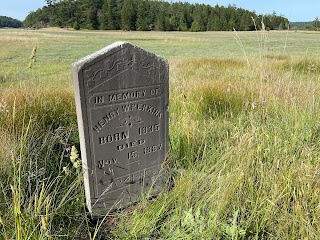
From left to right: An area covered with big head sedge, Carex macrocephala, on Henry Island. A close-up of big head sedge brown flower spike. Botanizing on the salt marsh on the Henry Island preserve. Pickleweed, Salicornia virginica, on Henry Island. A tombstone on the Henry Island preserve.




From left to right: A grassy path on the Henry Island preserve. A view over Nelson Bay from Henry Island. A view of Open Bay on Henry Island. A path through the forest on Henry Island with a small book library kiosk. Ocean spray, Holodiscus discolor, on Henry Island.
Spieden Island
Over the two days of prawning, we did so around the northwest end of Spieden Island. The island has a split personality and an interesting history. The island is about 2 miles long and a half mile wide at its widest, and runs approximately east to west. The north side of the island is lush and green while the south side of the island is brown and mostly barren. The dividing line between the two halves runs along the spine of the hill that more or less runs the length of the island. On the brown side, there are scattered boulders called glacial erratics.
We keep motoring off the shores of Spieden Island, dropping traps, picking up traps, and then vainly searching for one that got lost. The island calls to be explored. We would have loved to, but it's private.
Spieden Island was also named by Charles Wilkes during the Wilkes Expedition of 1838–1842, to honor William Speiden, the purser of the expedition's Peacock.
In the 1970s, the island was briefly a game reserve, a venture that didn't last long. But a number of exotic animals were imported to the island. In one of the lull times between setting traps and going back to collect them (about 1-2 hours), we spot deer and then sheep that we can't easily identify. Left over exotics? Their identity will have to remain a mystery for now just like the island.
A boating life
One day we head into Roche Harbor to gas up our tooling-around Grady White boat. (The boat we sleep on is much larger, with state rooms.) The boating life runs on fuel. As we pull in slowly to the harbor – to avoid creating a wake – our friend refers to the collection of boats as a "fiberglass farm". She refers specifically to the power boats. There are handsome boats and there are ugly boats. Sleek boats and bloated boats. Big boats and small boats. All run on some form of fuel, even sail boats. Our fuel fill up comes with a sobering bill of four hundred dollars. Ancient fossils power our traipsing around.
Roche Harbor sits at the north end of San Juan Island and is an official point of entry into the US. The Canadian border is a stone's throw away. Roche Harbor is also a popular destination-wedding location for it's accessibility (nearby airport), natural beauty, and things to do.



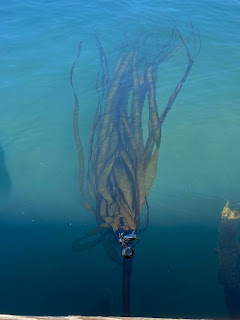

Left: A view at dusk of San Juan Island from Henry Island. Center left: Sea life caught in the shrimp trap and released back. Center: A jellyfish near Henry Island. Center right: Seaweed attached to a pier near Henry Island. Right: Looking out the back of our Grady White.
Parking your boat in Roche Harbor, you can easily reach the nearby roadside attraction called the "Afterglow Vista", formerly known as the John S. McMillin Memorial Mausoleum. The mausoleum was completed in in 1936 and is full of masonic and biblical symbols important to McMillin.
A little farther from Roche Harbor is the Westcott Bay Shellfish Company. We instead arrive there one day by boat, lazily motoring through the serene Westcott Bay looking at the real estate we probably can't afford. You can eat at Westcott, but we buy a couple dozen oysters and take them back for dinner on the boat.
The Oysterater site says of oysters, "[t]hey are as close as you can come to eating the sea and getting away with it." All the Wescott Oysters we buy are called High Beach Sweets but are essentially Pacific oysters (Magallena gigas), an introduced species from Japan. The Pacific oyster was imported in the 1930s to save the West Coast oyster industry after the native Olympia oyster (Ostrea lurida) was nearly wiped out. The Pacific oyster is the main oyster used today worldwide, from France to China. The different types of Pacific oysters can be chalked up to cultivation and merroir.
Coda: sea as it glides
The day has been melting awayWe've been lying on the shore for a whileAnd the sun is stillAnd you are the sea as it glides




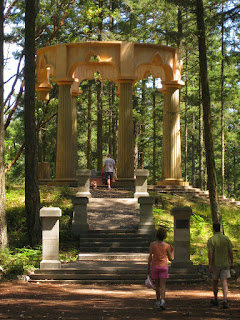

From left to right: Spot prawns (Pandalus platyceros) in a trap. Spot prawns in a blue holding bucket. A coonstripe shrimp in a yellow glove. Fruit for breakfast - it's not all fish in the boating life. Approaching the Afterlife Vista monument near Roche Harbor. Information about the Afterglow Vista monument.







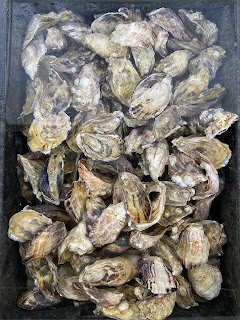


No comments:
Post a Comment
All comments are moderated. If your comment doesn't appear right away, it was likely accepted. Check back in a day if you asked a question.